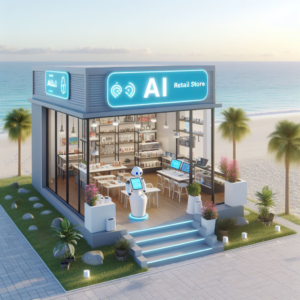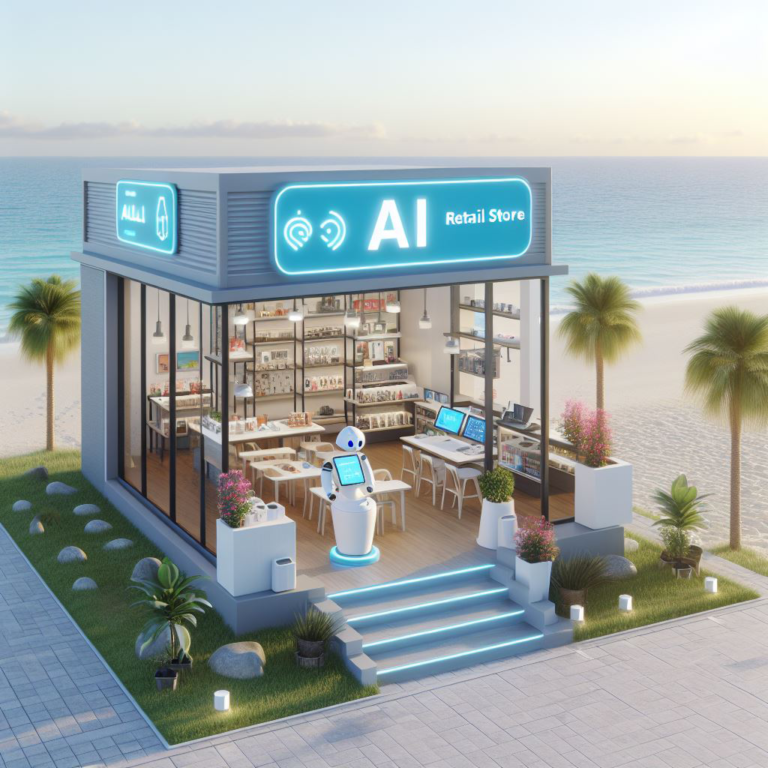Unleashing the Power of AI Revolutionizing Digital Marketing to Brand Success

Digital marketing is the cornerstone of brand visibility and engagement in today’s hyper-competitive landscape. As businesses strive to capture the attention of their target audience amid the digital noise, the integration of artificial intelligence (AI) into advertising strategies emerges as a game-changer.
From personalized advertising campaigns to real-time optimization and enhanced creativity, AI-driven solutions are reshaping the dynamics of branding and consumer engagement. In this comprehensive guide, we delve into the transformative impact of AI across various facets of digital marketing, exploring how leading corporations harness AI to elevate their branding initiatives and drive unparalleled ROI. Join us as we unravel the future of digital marketing, where AI innovation converges with branding prowess to unlock limitless possibilities in the ever-evolving landscape of online advertising.
|
AI Application |
Example |
Corporation |
|
Personalized Advertising |
Coca-Cola tailors ads with AI algorithms |
Coca-Cola |
|
Starbucks uses AI for personalized promotions |
Starbucks |
|
|
Netflix recommends content with AI algorithms |
Netflix Inc. |
|
|
Spotify creates personalized playlists with AI technology |
Spotify Technology S.A. |
|
|
Real-time Optimization |
Google Ads optimizes bids in real-time with AI |
Google (Alphabet Inc.) |
|
Microsoft Advertising adjusts ad strategies in real-time |
Microsoft Corporation |
|
|
TikTok delivers real-time ads with AI technology |
TikTok (ByteDance Ltd.) |
|
|
Twitter automates ad targeting and optimization with AI |
Twitter Inc. |
|
|
Enhanced Creativity |
Adobe Sensei revolutionizes creative content creation |
Adobe Inc. |
|
IBM Watson analyzes trends for innovative ad campaigns |
IBM Corporation |
|
|
OpenAI’s GPT-3 generates engaging ad copy with AI |
OpenAI |
|
|
Automation and Efficiency |
Facebook’s Ads Manager streamlines ad processes with AI |
Meta Platforms, Inc. (formerly Facebook, Inc.) |
|
LinkedIn automates ad placement and targeting with AI |
LinkedIn (Microsoft Corporation) |
|
|
Pinterest automates campaign optimization with AI |
Pinterest Inc. |
|
|
Improved ROI |
Amazon Advertising optimizes strategies with AI algorithms |
Amazon.com, Inc. |
|
Walmart enhances ROI with AI-driven analytics |
Walmart Inc. |
|
|
Shopify maximizes advertising effectiveness with AI tools |
Shopify Inc. |
|
|
Alibaba’s Alimama delivers targeted marketing with AI |
Alibaba Group Holding Limited |
|
|
Ethical Considerations |
Microsoft Advertising prioritizes privacy and transparency |
Microsoft Corporation |
|
Apple emphasizes ethical AI usage in advertising |
Apple Inc. |
Crafting Digital Brand Experiences: CX, AI, and Emerging Trends in Brand Engagement

Digital branding is continually evolving, driven by technological advancements and consumer behavior shifts. Combined with customer experience (CX) strategies and artificial intelligence (AI) capabilities, it can lead to innovative approaches that enhance brand engagement and loyalty.
Here are some upcoming trends in digital branding with a focus on CX and AI:
Hyper-Personalization
- Trend: Brands will increasingly leverage AI and data analytics to deliver hyper-personalized experiences tailored to individual preferences and behaviors.
- CX Impact: Hyper-personalization allows brands to anticipate customer needs and deliver targeted content, products, and offers, leading to higher engagement and conversion rates.
- AI Implementation: AI-powered recommendation engines, predictive analytics, and Chabot enable brands to analyze vast customer data in real time and deliver personalized experiences across digital touchpoints.
- Example: An online fashion retailer uses AI algorithms to analyze customer browsing behavior, purchase history, and social media interactions. Based on this data, the retailer sends personalized product recommendations via email and retargets customers with dynamic ads featuring items they have shown interest in.
- Sectors: E-commerce, retail, subscription services.
- Trend: Brands will invest in interactive content formats such as quizzes, polls, and immersive storytelling to engage audiences and create memorable brand experiences.
- CX Impact: Interactive content encourages active participation from users, fostering deeper engagement and emotional connections with the brand.
- AI Implementation: AI-driven content personalization tools can dynamically adapt interactive experiences based on user interactions and preferences, enhancing relevance and effectiveness.
- Example: A cosmetics brand creates an interactive quiz on its website to help customers find their perfect shade of foundation. Users answer questions about their skin type, preferences, and makeup routine, and the quiz generates personalized product recommendations tailored to their needs.
- Sectors: Beauty and cosmetics, lifestyle brands, consumer goods.
Voice and Conversational AI
- Trend: With the growing popularity of voice assistants and smart speakers, brands will optimize their digital presence for voice search and conversational interactions.
- CX Impact: Voice-enabled experiences provide convenience and accessibility for users, allowing them to interact with brands naturally using voice commands.
- AI Implementation: Brands will leverage AI-powered Chabot and voice assistants to automate customer interactions, answer queries, and provide personalized recommendations in real time.
- Example: A fast-food chain implements a voice-enabled ordering system via its mobile app and voice assistants. Customers can place orders, customize their meals, and track delivery status using voice commands, enhancing convenience and accessibility.
- Sectors: Food and beverage, hospitality, retail.
- Trend: Visual search and AR technologies will enable consumers to discover products and experiences through images and real-world environments.
- CX Impact: Visual search and AR enhance the shopping experience by allowing users to find and visualize products in their context, leading to more informed purchase decisions.
- AI Implementation: AI algorithms power visual search engines and AR applications, enabling accurate object recognition, image analysis, and virtual product try-on experiences.
- Example: A furniture retailer launches an AR app that allows customers to visualize how different pieces of furniture would look in their home. Users can virtually place sofas, tables, and decor items in their living space using their smartphone camera, helping them make informed purchase decisions.
- Sectors: Home furnishings, interior design, home improvement.
- Trend: Brands will focus on developing emotionally intelligent interactions that resonate with customers on a deeper level and evoke positive feelings.
- CX Impact: Emotionally intelligent interactions build trust, loyalty, and brand affinity, fostering long-term relationships with customers.
- AI Implementation: AI-powered sentiment analysis, emotion recognition, and natural language processing enable brands to gauge customer sentiment and tailor interactions based on emotional cues.
- Example: A telecommunications company uses sentiment analysis and natural language processing to gauge customer emotions during support interactions. If a customer expresses frustration or dissatisfaction, the AI-powered system automatically escalates the issue to a human agent for personalized assistance and resolution.
- Sectors: Telecommunications, customer service, technology.
AI-Driven Content Creation and Personalization
- Trend: AI technologies will play an increasingly prominent role in content creation, optimization, and personalization, enabling brands to scale their content efforts and deliver relevant messaging.
- CX Impact: AI-driven content personalization improves relevance and resonance, increasing engagement and conversion rates.
- AI Implementation: AI-powered content generation tools, natural language processing algorithms, and machine learning models enable brands to automate content creation, optimize messaging, and tailor content to specific audience segments.
- Example: A travel agency uses AI-powered content generation tools to automate the creation of personalized travel itineraries for customers. The system analyzes customer preferences, travel history, and destination interests to generate customized trip plans with hotel recommendations, activity suggestions, and local insights.
- Sectors: Travel and tourism, hospitality, entertainment.
Data Privacy and Ethical AI
- Trend: Brands will prioritize data privacy and ethical AI practices to build trust and transparency with consumers.
- CX Impact: Respecting customer privacy and data rights enhances brand credibility and fosters a positive perception among consumers.
- AI Implementation: Brands will implement AI technologies with built-in privacy controls, data encryption, and transparent data usage policies to ensure compliance with regulations and protect customer data.
- Example: A financial services company implements AI-powered fraud detection systems while ensuring compliance with data privacy regulations such as GDPR and CCPA. The company employs encryption, anonymization, and access controls to protect customer data and maintains transparency about its data usage practices.
- Sectors: Financial services, healthcare, legal services.
EVOLUTION OF RETAIL NAVIGATING THE STRATEGY CHALLENGES AND OPPORTUNITIES FOR BRANDING IN 2024

Exploring the changes happening in retail-landscape and the impact on branding, customer services, and retail operations.
Reflecting on my journey in retail, which began in 2005 as a sales assistant at the Boots in London, I’ve witnessed firsthand the profound transformations in the retail industry. During my time at Boots, I gained valuable insights into high street retail, interacting with customers, and experiencing the demands of the ever-changing market environment.
Back then, high street retailers like Boots were at the forefront of retail innovation, offering a blend of quality products and personalized customer service. However, even in those early days, the seeds of change were already being sown, with the emergence of digital media and the beginnings of e-commerce reshaping consumer behaviors and expectations.
Fast forward to 2024, and the retail landscape looks vastly different. The rise of e-commerce giants, shifting consumer preferences, and disruptive technological advancements have redefined the rules of engagement for retailers. Brands are now compelled to embrace digital transformation, prioritize Omni channel experiences, and leverage data-driven insights to stay relevant in a hypercompetitive market.
As someone who has navigated the evolution of retail from the shop floor to the digital realm, I’ve seen firsthand the impact of these changes on branding, customer services, and retail operations. Today, effective branding goes beyond traditional marketing tactics; it requires a deep understanding of consumer behavior, agile communication strategies, and a commitment to delivering seamless experiences across all touch points.
In this dynamic and ever-evolving landscape, retailers must continually adapt and innovate to meet the evolving needs and expectations of modern consumers. By embracing the opportunities presented by digital media, harnessing the power of data-driven insights, and fostering authentic connections with customers, brands can not only survive but thrive in the digital age.
In conclusion, while the journey from my early days at Boots to the present day has been marked by significant changes and challenges, it has also been defined by endless opportunities for growth and innovation. By staying agile, embracing change, and putting the customer at the center of everything we do, we can navigate the complexities of the modern retail landscape and build brands that stand the test of time.
Elevating Hospitality with
Digital Strategy, Branding, and Customer Service Experience

During my time at Mercure Leeds in 2012, part of the prominent Accor Group, I occupied myself in the world of hospitality, serving as an F&B and customer service operation assistant. This role provided precious insights into event coordination, food and beverage service, and delivering outstanding guest experiences.
Reflecting on this period, it’s clear that hospitality has changed ominously in the past era, driven by digitalization. With consumers gradually engaging through digital channels, branding hospitality has transcended traditional boundaries, requiring a holistic approach that integrates physical and digital touch points seamlessly.
The progress of service in hospitality has been insightful, emphasizing personalized experiences facilitated by digital platforms. Today’s guests expect seamless interactions across several channels, encouragement a review of service delivery to meet evolving preferences.
The COVID-19 pandemic has accelerated these trends, highlighting the importance of hygiene and safety protocols. Hospitality establishments have modified operations to ensure amenability while maintaining service quality.
Moreover, the rise of food delivery systems presents both challenges and opportunities. While App-based ordering expands reach, it intensifies competition, driving innovation to stand out in the marketplace.
Advancements in technology, including AI-driven systems and data analytics, offer opportunities to enhance guest experiences and operational efficiencies. Leveraging these tools provides insights into consumer behavior and cultivates sustainable competitive advantages.
As we navigate this transformative landscape, embracing digitalization and prioritizing guest-centricity are crucial. By raising innovation, hospitality professionals can thrive in an increasingly competitive environment.
In conclusion, the digital transformation of hospitality requires strategic adaptation and innovation. Embracing these changes enables professionals to drive growth and success within the industry.
Navigating Generational Shifts: Adapting Products to Changing Consumer Preferences
In the ever-evolving landscape of consumer preferences, businesses must stay attuned to the diverse tastes and needs of different generations. Here, we explore various product categories and the adaptations needed to resonate with each generation, along with potential timelines for introduction:
Sustainable and Eco-Friendly Products
Product Examples:
- Clothing: Introduction of organic cotton t-shirts, recycled polyester activewear, and biodegradable footwear.
- Personal Care: Launch of cruelty-free cosmetics, refillable skincare containers, and bamboo toothbrushes.
- Home Goods: Offering eco-friendly cleaning supplies, compostable kitchenware, and energy-efficient appliances.

Timeline for Introduction
- Immediate: Basic sustainable alternatives like bamboo toothbrushes and reusable water bottles.
- Short-Term (1-2 years): Expansion into clothing and personal care with organic and recycled materials.
- Mid-Term (3-5 years): Adoption of advanced sustainable practices like carbon-neutral production and closed-loop recycling.
Health and Wellness Products:
Product Examples:
- Nutrition: Launch of plant-based protein bars, probiotic supplements, and adapt genic drinks.
- Fitness: Introduction of home gym equipment, smart workout gear, and virtual fitness classes.
- Mental Health: Offering meditation apps, aromatherapy diffusers, and stress-relief gadgets.
Timeline for Introduction
- Immediate: Wellness apps and basic fitness equipment.
- Short-Term (1-2 years): Expansion into specialized nutrition and fitness products.
- Mid-Term (3-5 years): Integration of AI-driven health tracking devices and personalized wellness solutions.
Technology and Gadgets:
Product Examples:
- Smartphones: Launch of 5G-enabled devices with advanced camera features and AI capabilities.
- Wearable Tech: Introduction of smart watches with health monitoring sensors and augmented reality glasses.
- Home Automation: Offering smart speakers, connected thermostats, and AI-powered home security systems.
Timeline for Introduction
- Immediate: Upgrades to existing models with incremental improvements.
- Short-Term (1-2 years): Integration of AI and IoT technology for enhanced user experiences.
- Mid-Term (3-5 years): Development of next-gen devices with seamless connectivity and predictive functionalities.
Convenience and On-Demand Services
Service Examples:
- Food Delivery: Expansion of meal kit delivery services, ghost kitchens, and drone food delivery.
- Transportation: Introduction of ride-sharing subscriptions, autonomous vehicle rentals, and hyperloop transportation.
- Home Services: Offering on-demand cleaning, repair, and pet care services through mobile apps.
Timeline for Introduction
- Immediate: Adoption of existing on-demand services like food delivery and ride-sharing.
- Short-Term (1-2 years): Expansion into niche services like pet grooming and home maintenance.
- Mid-Term (3-5 years): Integration of AI for predictive service recommendations and seamless user experiences.
Entertainment and Media
Product Examples:
- Streaming Services: Launch of niche content platforms catering to specific interests and demographics.
- Gaming: Introduction of cloud gaming services, virtual reality gaming experiences, and esports tournaments.
- Social Media: Offering alternative social networking platforms focused on privacy and community engagement.
Timeline for Introduction
- Immediate: Expansion of existing streaming and gaming platforms with new content and features.
- Short-Term (1-2 years): Introduction of experimental formats like interactive storytelling and immersive experiences.
- Mid-Term (3-5 years): Adoption of emerging technologies like blockchain for content distribution and decentralized social networks.
Fashion and Beauty
Product Examples:
- Apparel: Launch of gender-neutral clothing lines, customizable fashion, and rental subscription services.
- Beauty: Introduction of inclusive makeup shades, sustainable packaging, and AI-powered skincare analysis.
- Accessories: Offering smart jewelry, biodegradable eyewear, and upcycled handbags.
Timeline for Introduction
- Immediate: Inclusivity initiatives like diverse model representation and size-inclusive clothing.
- Short-Term (1-2 years): Expansion into sustainable and tech-infused fashion and beauty products.
- Mid-Term (3-5 years): Adoption of advanced customization options and innovative materials like lab-grown textiles.
Implementation Example
Consider a fashion retailer aiming to appeal to Gen Z and Millennial. They could introduce a sustainable fashion line made from recycled materials and eco-friendly fabrics. This line could include customizable options allowing customers to personalize their garments, aligning with the desire for unique and ethical fashion choices. By leveraging digital platforms and social media marketing, the retailer could effectively communicate their sustainability initiatives and engage with environmentally conscious consumers.
Techville's Global Journey: The NeuraTrend Story

In the vibrant year of 2024, technology has reshaped the world in ways few could have imagined. This is the story of NeuraTrend, a startup that brought together a group of friends from different corners of the globe, each contributing their unique skills to create something extraordinary. Their journey covers finance, medical, education, communication, and logistics, demonstrating how modern technology
A Global Idea
Emma, the visionary, sat in her cozy apartment, staring at her holographic desk. The idea for NeuraTrend sparked as she sipped her AI-brewed coffee, customized perfectly to her taste by a machine that understood her better than anyone else. “We need a brand that stands out,” she thought.
Thousands of miles away in Bangalore, Maria was busy integrating AI-driven chatbots into customer service systems. “Customer Experience (CX) is key,” she mused, ensuring her bots were equipped with advanced natural language processing (NLP) to handle queries with human-like understanding.
Meanwhile, in Sao Paulo, Leo was setting up IoT sensors throughout their warehouse. “Efficiency is everything,” he muttered, checking the data streams that monitored conditions and automated maintenance tasks.
In Berlin, Jake was analyzing blockchain applications for secure transactions. “Trust is fundamental in finance,” he said, securing their financial operations with transparent and tamper-proof technology.
The Virtual Team
Despite the distances, the team worked seamlessly thanks to tech-based communication. Their virtual meetings were held in a digital collaboration suite, where each person appeared as a lifelike avatar. In this shared space, they brainstormed ideas as naturally as if they were in the same room.
Maria in Bangalore focused on integrating telemedicine services into their health offerings. “Patients need access to doctors, regardless of their location,” she said, setting up AI-driven diagnostic tools that could assist doctors in remote areas.
Virtual Reality Retail
NeuraTrend’s first major project was a virtual store. Customers around the world could use Virtual Reality (VR) headsets to shop from the comfort of their homes. “Imagine walking through our store and interacting with products virtually,” Emma explained during one of their holographic meetings.
In Tokyo, the team launched the virtual store, allowing customers to receive personalized recommendations from virtual assistants. This immersive shopping experience was far beyond the e-commerce websites of 2010, blending augmented reality (AR) to enhance the user experience.
Seamless Operations
As the business grew, Leo in Sao Paulo continued to refine their operations. He integrated robotic process automation (RPA) to handle repetitive tasks, freeing up the team for more strategic work. “Automation is our secret weapon,” he said, watching robots perform inventory checks.
In Nairobi, Maria expanded their customer service capabilities. She used predictive analytics to anticipate customer needs and tailor their experience accordingly. “We’re not just solving problems; we’re predicting them,” she noted, as AI-driven insights guided their strategies.
Education and Training
In Seoul, Emma partnered with local schools to implement e-learning platforms. “Education should be accessible to everyone,” she declared. Using AI, these platforms adapted to each student’s learning style, providing a personalized education experience that could compete with traditional classroom settings.
Maria also developed VR-based training programs for their employees, ensuring they stayed ahead of the technological curve. “Continuous learning is vital,” she said, as employees engaged with interactive and immersive training modules.
Medical Advancements
Jake’s next project involved incorporating AI in medical diagnostics. From Berlin, he collaborated with hospitals to implement systems that could analyze medical images and predict disease outcomes with high accuracy. “Healthcare must evolve,” he said, ensuring that their technology could save lives and improve patient care.
Maria, leveraging her telemedicine services, connected rural clinics with specialists in urban centers. “We bridge the gap,” she explained, providing access to quality healthcare regardless of geography.
Financial Technology
NeuraTrend also ventured into fintech. Emma oversaw the development of AI-driven financial advisory services. “We can democratize financial advice,” she believed, offering tools that provided personalized investment strategies and budget planning.
Jake’s blockchain-secured transactions ensured that all financial activities were transparent and secure, building trust with their customers. “Our financial integrity is our strength,” he emphasized, integrating smart contracts to automate and enforce agreements.
Reflecting on the Journey
One evening, the team gathered virtually to celebrate their latest milestone. Emma reflected on their journey. “In 1980, this would have been science fiction. Even in 2010, we were just scratching the surface. Now, in 2024, these technologies are our reality.”
Jake nodded. “The combination of AI, VR, AR, IoT, and blockchain has transformed every aspect of our business.”
Maria added, “And it’s not just about the technology. It’s about how we use it to create value for our customers and make our operations more efficient.”






